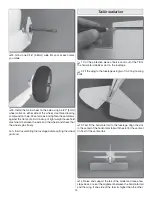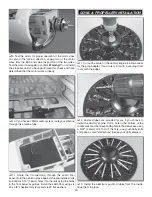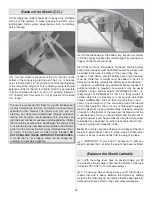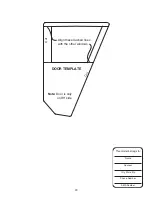
28
Takeoff directly into the wind. Gradually advance the throttle
while holding a bit of up elevator to keep the tail on the ground
to maintain tail wheel steering. Also start applying right rudder.
If the throttle is advanced too quickly, the plane will want to
turn quickly to the left. As the model gains speed, decrease
up elevator allowing the tail to come off the ground. Gain as
much speed as your runway and flying site will practically
allow before gently applying up elevator, lifting the model into
the air. Be smooth on the elevator stick, allowing the model to
establish a
gentle
climb to a safe altitude before turning into
the traffic pattern.
Flight
For reassurance and to keep an eye on other traffic, it is a
good idea to have an assistant on the flight line with you. On
the first flight the assistant can help you adjust the trims.
In the air, the Mister Mulligan flies similar to a sport plane.
It can perform the basic aerobatic maneuvers; loops, rolls,
stall turns and wing overs. Be mindful of the flight time. With
electric planes it is best to have a timer set so that the plane
can be landed with power to spare, just in case you have to
abort the landing and go around. A dead stick with an electric
plane is the same as a dead stick with a glow plane. Risky!
Landing
RBefore the battery power drops, make a few passes with
the flaps down to see how the plane slows down. If this is
your first plane equipped with flaps, here are a couple of
notes on how to land with flaps. Only lower the flaps at half
throttle or less. When the flaps are lowered, the plane will
balloon up slightly, then, level off as the speed slows. On final
approach, keep the power on and control the descent with
the throttle. The plane will land slower with flaps than without.
Don’t let the plane get to slow, even with flaps the plane can
tip stall if it gets too slow.
One final note about flying the Mister Mulligan. Have a goal or
flight plan in mind for
every
flight. This can be learning a new
maneuver(s), improving a maneuver(s) you already know,
or learning how the model behaves in certain conditions
(such as on high or low rates). This is not necessarily to
improve your skills (
though it is never a bad idea!
), but more
importantly so you do not surprise yourself by impulsively
attempting a maneuver and suddenly finding that you’ve run
out of time, altitude or airspeed. Every maneuver should be
deliberate, not impulsive. For example, if you’re going to do a
loop, check your altitude, mind the wind direction (anticipating
rudder corrections that will be required to maintain heading),
remember to throttle back at the top, and make certain you
are on the desired rates (high/low rates). A flight plan greatly
reduces the chances of crashing your model just because of
poor planning and impulsive moves.
Remember to think.
Have a ball!
But always stay in control and fly in a safe manner.
GOOD LUCKAND GREAT FLYING!





































